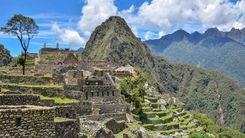Paracas National Reserve
Of greater wildlife interest than the Ballestas Islands, the Paracas National Reserve, a few kilometres south of Paracas, was established in 1975, mainly to protect the marine wildlife. Its bleak 117,000 hectares of pampa are frequently lashed by strong winds and sandstorms (paracas means “raining sand” in Quechua). Home to some of the world’s richest seas (a couple of hundred hectares of ocean is included within the reserve’s borders), an abundance of marine plankton gives nourishment to a vast array of fish and various marine species including octopus, squid, whale, shark, dolphin, bass, plaice and marlin. This unique desert is also a staging point for a host of migratory birds and acts as a sanctuary for many endangered species. Schools of dolphin play in the waves offshore; condors scour the peninsula for food; small desert foxes come down to the beaches looking for birds and dead sea lions; and lizards scrabble across the hot sands. People have also been active here – predecessors of the pre-Inca Paracas culture arrived here some 9000 years ago, reaching their peak between 2000 and 500 BC.
On the way from Pisco to the reserve, the road passes some unpleasant-smelling fish-meal-processing factories, which are causing environmental concern due to spillages of fish oil that pollute the bay, endangering bird and sea-mammal life. Just before the entrance to the reserve, you’ll pass a bleak but unmistakeable concrete obelisk vaguely shaped like a nineteenth-century sailing boat, built in 1970 to commemorate the landing of San Martín here on September 8, 1820, on his mission to liberate Peru from the Spanish stranglehold.
Cycling is encouraged in the reserve, though there are no rental facilities and, if you do enter on a bike, keep on the main tracks because the tyre marks will damage the surface of the desert.



